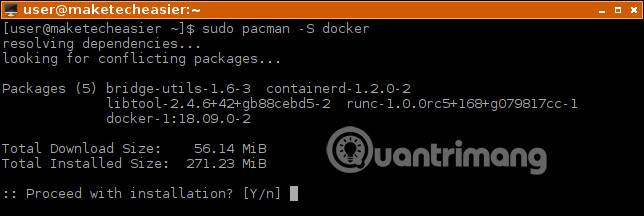How to install Docker in Linux
Virtualization and containers are constantly increasing in popularity. The reason is because they help enhance security and provide mobility to users.
For example, if you use some cloud services, they will help separate data and services more easily. But their use is not limited to that. If you are a Linux application developer, you will quickly realize just how difficult it is to make the application available to all Linux distributions.
When the program you create works in Ubuntu, making it work in Arch Linux, Debian and other distributions is not as simple as you think. Each distribution will be different and you must make adjustments so that the utilities are available in each distribution.

Containerization process makes development easier and can be deployed anywhere. Instead of relying on the operating system to provide what the application needs, all dependencies are bundled in the container itself. When the container is active, users can move it from one computer to another and between different operating systems easily.
Docker is a containerized utility that has become very popular, simplifying such tasks. Moreover, when there is a problem with the operating system, instead of installing and reconfiguring the application, users only need to reinstall the operating system, copy the container again.
Instructions for installing Docker on some Linux distributions
- Delete the old Docker settings
- How to install Docker on Ubuntu
- How to install Docker on Debian
- How to install Docker on Fedora
- How to install Docker on Arch Linux
Delete the old Docker settings
This is an optional step, required only if the old version of Docker is installed. They may conflict with new versions, especially if they come from different repositories than what is used here.
On Debian or Ubuntu, 'clean up' everything with:
sudo apt --purge autoremove docker docker-engine docker.io containerd runc On Fedora:
sudo dnf remove docker docker-client docker-client-latest docker-common docker-latest docker-latest-logrotate docker-logrotate docker-selinux docker-engine-selinux docker-engine How to install Docker on Ubuntu
Open the terminal and install the prerequisites.
sudo apt update && sudo apt install software-properties-common gnupg2 curl ca-certificates apt-transport-https Check Docker's fingerprint GPG key.
curl -fsSL https://download.docker.com/linux/ubuntu/gpg | gpg 
At the time of writing, the fingerprint is: 9DC858229FC7DD38854AE2D88D81803C0EBFCD88. This may change in the future. Check Docker's official website to see if they match. The key is used to verify the electronic signature, so users can ensure the software being installed is legitimate and not malicious software uploaded by the attacker to the server.
Once you've made sure you have the correct key, add it to APT's trusted keys.
curl -fsSL https://download.docker.com/linux/ubuntu/gpg | sudo apt-key add - Add the Docker repository for Ubuntu to the software source.
sudo add-apt-repository "deb [arch=amd64] https://download.docker.com/linux/ubuntu $(lsb_release -cs) stable" Install Docker.
sudo apt update && sudo apt install docker-ce If you need Docker Compose, users can install it with:
sudo apt install docker-compose Most Docker commands need to be started with sudo. If you want to avoid having to enter your password each time, add users to the Docker group.
sudo adduser $USER docker Log out of the graphical user interface and log in again. Now, users can use commands like ps docker instead of sudo docker ps.
How to install Docker on Debian
Because Ubuntu is made from Debian, the steps are very similar.
sudo apt update && sudo apt install software-properties-common apt-transport-https ca-certificates curl gnupg2 Check the fingerprint to see if it is the same as in the previous section.
curl -fsSL https://download.docker.com/linux/debian/gpg | gpg Add reliable keys.
curl -fsSL https://download.docker.com/linux/debian/gpg | sudo apt-key add - Add software source.
sudo add-apt-repository "deb [arch=amd64] https://download.docker.com/linux/debian $(lsb_release -cs) stable" Install Docker.
sudo apt update && sudo apt install docker-ce If you need Docker Compose, install it with:
sudo apt install docker-compose To use Docker commands without setting sudo in front:
sudo adduser $USER docker Then log out and log in again.
How to install Docker on Fedora
Install prerequisites.
sudo dnf install dnf-plugins-core Add the Docker software store.
sudo dnf config-manager --add-repo https://download.docker.com/linux/fedora/docker-ce.repo Install Docker.
sudo dnf install docker-ce 
On some systems, this will take some time to complete and there seems to be no progress at all. But do not cancel the operation. Of course, the installation process may actually be problematic, but take at least ten minutes to do the work on slow computers.
Allow automatic launch of Docker when booting.
sudo systemctl start docker.service Start Docker.
sudo systemctl start docker.service Add yourself to the Docker group.
sudo usermod -aG docker $USER Log out and log back on to the graphical user interface.
Anyone who needs Docker Compose can install it with:
sudo dnf install docker-compose How to install Docker on Arch Linux
Arch has included Docker in his community repository, so the installation process will be easier.
sudo pacman -S docker 
If you need Docker Compose:
sudo pacman -S docker-compose Add yourself to the Docker group:
sudo usermod -aG docker $USER Log out of the graphical user interface and log back in for the installation to take effect.
Allow Docker to automatically start when booting.
sudo systemctl enable docker Start Docker.
sudo systemctl start docker Obviously, this article does not cover all existing distributions. But if you're using something like openSUSE, you may be lucky to find a tutorial page on how to install Docker on that distribution at en.opensuse.org/SDB:Docker
Good luck!
See more:
- 5 tips to learn Docker effectively for beginners
- How to safely check desktop applications with Docker
- 5 useful tips to learn Docker
You should read it
- Docker best practices you need to know
- Docker Hub is used by hackers to spread Cryptojacking malware
- 10 Best Docker Alternatives 2022
- How to Containerize a Nest.js Application Using Docker and Docker Compose
- How to safely check desktop applications with Docker
- Containerize Go App with Docker
- 6 reasons to use Docker virtualization software
- 5 useful tips to learn Docker in 2018
May be interested
- 5 useful tips to learn Docker in 2018
 do you want to study docker in 2018? here are 5 helpful tips that can help you learn docker effectively.
do you want to study docker in 2018? here are 5 helpful tips that can help you learn docker effectively. - Containerize Go App with Docker
 learn how to use docker to efficiently package and deploy go applications, making them flexible and manageable. here are detailed instructions.
learn how to use docker to efficiently package and deploy go applications, making them flexible and manageable. here are detailed instructions. - How to Install and Use Grafana for Real-Time Data Visualization
 this tutorial will show you how to install grafana using docker and how to use this tool to monitor system metrics and visualize real-time data effectively.
this tutorial will show you how to install grafana using docker and how to use this tool to monitor system metrics and visualize real-time data effectively. - Common commands in Docker
 docker is a computer program that performs os-level virtualization, also known as containerization.
docker is a computer program that performs os-level virtualization, also known as containerization. - How to run Python scripts using Docker
 running python scripts is one of the most common tasks in automation. however, managing dependencies across multiple systems can be a challenge. that's where docker comes in.
running python scripts is one of the most common tasks in automation. however, managing dependencies across multiple systems can be a challenge. that's where docker comes in. - What is Docker Compose? Summary of knowledge about Docker compose
 docker compose is a tool used to define and run docker programs using multiple containers (multi-containers).
docker compose is a tool used to define and run docker programs using multiple containers (multi-containers). - 5 tips to learn Docker effectively for beginners
 to keep up with this new technology trend, many people are starting to learn docker. for beginners familiar with docker, please refer to the article below to achieve high results.
to keep up with this new technology trend, many people are starting to learn docker. for beginners familiar with docker, please refer to the article below to achieve high results. - How to install and use Kali Linux on VmWare virtual machine
 until now, a famous linux distro, kali linux, has always been sought by security experts or hackers. why? simply because kali linux has a built-in range of tools for penetration, hacking, analysis, etc. all are categorized very clearly.
until now, a famous linux distro, kali linux, has always been sought by security experts or hackers. why? simply because kali linux has a built-in range of tools for penetration, hacking, analysis, etc. all are categorized very clearly. - How to install Solus Linux
 recently, the linux community has given winged compliments to solus linux. this is understandable because this is a beautiful operating system with lots of great features. in a world where most popular linux distributions are 'derivative ubuntu', solus linux really stands out.
recently, the linux community has given winged compliments to solus linux. this is understandable because this is a beautiful operating system with lots of great features. in a world where most popular linux distributions are 'derivative ubuntu', solus linux really stands out. - How to containerize a Rust app with Docker
 containerize rust apps with docker to simplify deployment and ensure consistency across different environments.
containerize rust apps with docker to simplify deployment and ensure consistency across different environments.










 5 best games on Ubuntu Snap Store
5 best games on Ubuntu Snap Store 20+ essential Linux security commands
20+ essential Linux security commands How to install Handbrake on Linux
How to install Handbrake on Linux The 5 most awaited things in Linux in 2019
The 5 most awaited things in Linux in 2019 How to create a burnable DVD copy on Linux with DevedeNG
How to create a burnable DVD copy on Linux with DevedeNG How to transfer files to / from Linux servers using SFTP
How to transfer files to / from Linux servers using SFTP